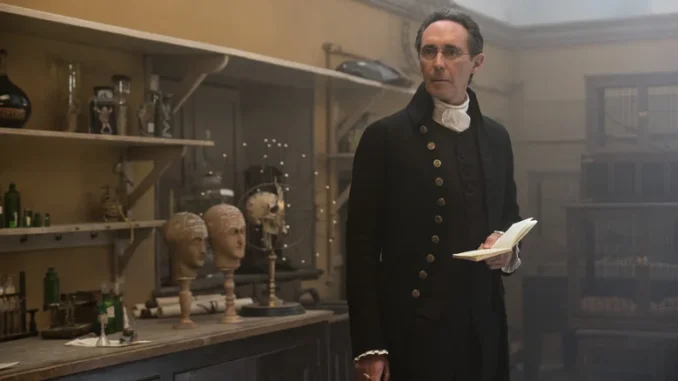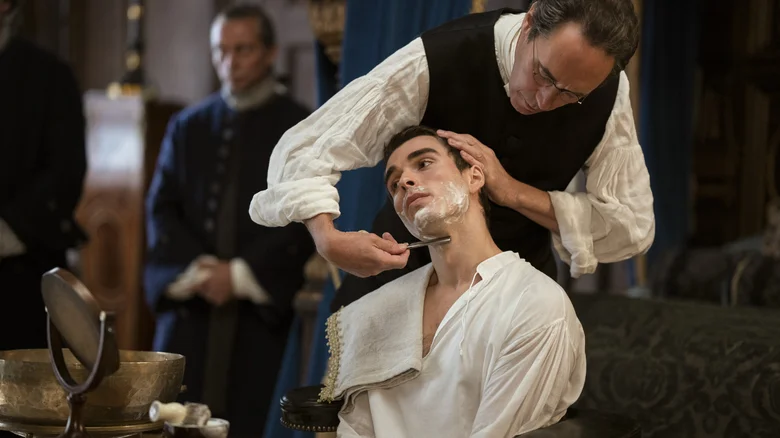
Since the beginning of Season 1, “Bridgerton” has had a pretty laissez-faire relationship with history. At times, it pulls quite directly from the real Regency era, while at others it creates its own fully distinct alternate history. Because of the show’s lush style and romance genre aesthetic, this balance works quite well. However, there’s one area where the series takes particular inspiration from real English history — specifically, with the character of King George III.
In the main “Bridgerton” series, George (played by James Fleet) is much more of a background character due in large part to the mysterious illness that keeps him in bed and off-camera for the majority of the time. Since Queen Charlotte (Golda Rosheuvel) is only a supporting character on the show, we only get snippets here and there of their tragic love story. What’s clear is that George is severely unwell, leaving his wife to rule almost entirely in his stead.
The prequel miniseries “Queen Charlotte: A Bridgerton Story” puts Charlotte (now played by India Amarteifio) and George (Corey Mylchreest) in the spotlight, revealing many more details about both their relationship and George’s mental health struggles. To be clear, there isn’t anything “wrong” with George here. He seems to have one or a couple of mental health conditions, which viewers have suggested could be a variation of bipolar disorder. In “Queen Charlotte,” his condition is arguably made far worse by the barbaric medical practices administered to “cure” him. When he’s much older in “Bridgerton,” George’s symptoms are more likely reflective of dementia. But how accurate are these portrayals of the real King George?
How King George III was treated in real life
In “Bridgerton,” King George typically remains in his own chambers and out of sight of the public, although he does dine from time to time with Queen Charlotte when he’s feeling well enough to do so. The “Queen Charlotte” prequel series shows a much younger George struggling with an early version of similar issues, but the real history doesn’t attach such diagnoses to the king until much later in his life. It was in the early 1800s, when “Bridgerton” took place, that consistent health issues forced George to essentially retire from his role as monarch. He was considered unfit to rule and formally replaced by his son in 1811.

“Queen Charlotte” depicts George as a young man obsessed with science and the stars but plagued by psychological struggles. However, the real King Geroge III was likely more concerned with political issues like the American Revolution. While his reputation as a “mad king” is overblown given the modern perspective on his likely mental conditions, his image as a tyrant both at home and abroad isn’t entirely unfounded.
The real King George suffered from similar conditions to his Bridgerton counterpart
Due to the medical technology of the time and the secrecy around the royal family, it’s impossible to say for certain what potential medical conditions the real King George III may have dealt with. That said, modern theories match up quite well to his depiction on “Bridgerton.” A 2015 study conducted by the University of Birmingham’s Timothy Peters utilizing “techniques of cognitive archeology” determined the same two conditions previously mentioned. Per the study, “The results of this analysis confirm that the king suffered from bipolar disorder type I, with a final decade of dementia, due, in part, to the neurotoxicity of his recurrent episodes of acute mania.”
In other words, George’s portrayal in the “Bridgerton” shows, while obviously highly dramatized, is actually quite accurate to what experts currently believe was actually the case. In both the show and in his day in the real world, George was written off as suffering from some form of “madness,” reflecting the leaps and bounds we’ve made in how we look at and talk about mental illness in the modern day.
Did Queen Charlotte’s cruel medical treatments on King George really happen?
As previously mentioned, the real King George III didn’t have major mental health crises (that we know of) until much later in his life than what’s depicted in the “Bridgerton” universe. That said, his retreats to Kew Palace, as depicted in “Queen Charlotte,” did occur in real life when was unwell. Those trips simply took place later on in his actual life.
